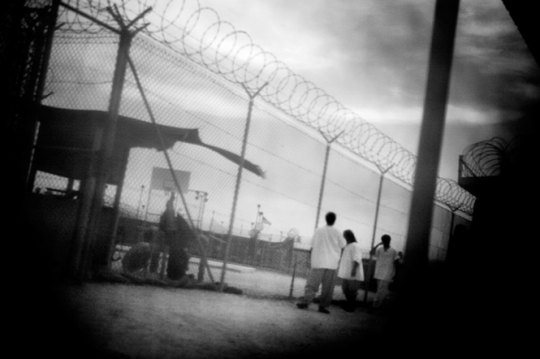Blowing the Whistle on CIA Torture from Beyond the Grave
ANGLO AMERICA, 20 Oct 2014
17 Oct 2014 – In the fall of 2006, Nathaniel Raymond, a researcher with the advocacy group Physicians for Human Rights, got a call from a man professing to be a CIA contractor. Scott Gerwehr was a behavioral science researcher who specialized in “deception detection,” or figuring out when someone was lying. Gerwehr told Raymond “practically in the first five minutes” that he had been at the U.S. prison at Guantanamo in the summer of 2006, but had left after his suggestion to install video-recording equipment in detainee interrogation rooms was rejected. “He said, ‘I wouldn’t operate at a facility that didn’t tape. It protects the interrogators and it protects the detainees,’” Raymond recalls.
Gerwehr also told Raymond that that he had read the CIA inspector general’s report on detainee abuse, which at the time had not been made public. But “he didn’t behave like a traditional white knight,” Raymond told The Intercept. Though he had reached out to Raymond and perhaps others, he didn’t seem like a prototypical whistleblower. He didn’t say what he was trying to do or ask for help; he just dropped the information. Raymond put him in touch with a handful of reporters, and their contact ended in 2007.
In 2008, at the age of 40, Gerwehr died in a motorcycle accident on Sunset Boulevard. Years after Gerwehr died, New York Times reporter James Risen obtained a cache of Gerwehr’s files, including emails that identify him as part of a group of psychologists and researchers with close ties to the national security establishment. Risen’s new book, Pay Any Price, uses Gerwehr’s emails to show close collaboration between staffers at the American Psychological Association (APA) and government officials, collaboration that offered a fig leaf of health-professional legitimacy to the CIA and military’s brutal interrogations of terror suspects.
Risen describes Gerwehr as “living a highly compartmentalized life.” A Santa Monica liberal who “expressed distaste for George Bush,” he was nonetheless tightly connected to people involved in the administration’s interrogation program. He had top secret/sensitive compartmented information clearance, according to Risen, and a psychologist told Risen “he seemed optimistic about the possibilities of testing out psychological theories on interrogation issues.” Indeed, in a 2005 New York Times op-ed that reads as almost naïve in the wake of the Abu Ghraib revelations, he and a co-author wrote that the idea “that harsh treatment of prisoners can be less effective than showing compassion…now deserves a test in Iraq.” Treating prisoners well “would help reverse the terrible propaganda defeat suffered with the revelations of torture at Abu Ghraib,” he wrote, and “prisoners released by our forces would return to their communities with stories of American generosity and tolerance.”
Risen says that Gerwehr’s files don’t contain “explosive bombshells,” or indicate “the extent of his knowledge of the CIA’s detention and interrogation programs.” But they narrate a period in 2004 and 2005 when the APA was being forced to respond to revelations about detainee abuse at Abu Ghraib and the role of psychologists in designing and condoning brutal questioning tactics. (Subsequent government investigations and reporting would show the foundational role of psychology, and in particular, two psychologists and CIA contractors, James Mitchell and Bruce Jessen.)
The APA in 2002 famously revised its ethics code to permit a psychologist to follow “governing legal authority” even if it clashed with the APA’s own code of ethics. It was, essentially, the Nuremberg Defense of “just following orders.” (In 2010 the APA definitively disavowed it.) As Risen writes, the 2002 change allowed psychologists to be involved in CIA and military interrogations, and “helped the lawyers in the Justice Department to argue that the enhanced interrogation program was legal because health professionals were monitoring the interrogations to make sure they stayed within the limits established by the Bush administration.”
In 2005, after the revelations of detainee abuse at Abu Ghraib, the APA put together a task force on ethics and national security, which, while affirming the organization’s opposition to torture, determined that psychologists could be involved with interrogations “to assist in ensuring that such processes are safe and ethical for all participants.”
Gerwehr was copied on emails discussing a confidential APA lunch meeting in July 2004, attended by psychologists from the CIA, Department of Defense, and other agencies. (The invited CIA psychologist, Kirk Hubbard, wrote that “all the DOD shrinks will be tied up…I will represent both of us.”) The draft proposal creating the task force was circulated to Gerwehr and others invited to the meeting before it was given to APA members. Other members of the task force later complained it was stacked in favor of the government, with six of the panel’s ten members having ties to the military or intelligence.
After the task force recommendation went public in 2005, the APA’s Mumford wrote an email thanking Hubbard for his “personal contribution…in getting this effort off the ground,” and mentioned that Susan Brandon, a Bush White House official, had “helped craft some language related to research” for the report. (Hubbard says that “I was not directly involved in the task force itself, though I know it was reported that I provided some input.” Brandon is now head of the research unit for the FBI’s high value detainee interrogation group, according to her bio for an upcoming conference. The FBI did not respond to a request for comment from Brandon. In a statement responding to Risen’s book, the APA said those contacts were “not in any manner unusual or inappropriate” and allowed “for frank discussion of the ethical and practice challenges facing psychologists working in national security settings.”)
Gerwehr’s emails about the APA also caught the interest of the FBI. In 2010, after learning of Gerwehr’s death and believing that he might have had critical information, Raymond sought out a meeting with John Durham, the assistant U.S. attorney who was leading the criminal probe related to CIA detention and interrogation. Durham had also been specifically tasked with looking into the CIA’s destruction of interrogation videotapes. (Raymond now directs the Harvard Humanitarian Initiative’s Signal Program on Human Security and Technology, which applies satellite imagery analysis and other technical approaches to humanitarian crises. He is mentioned as a researcher for an unnamed human rights group in Risen’s book, but his conversations with Gerwehr and the FBI are being reported for the first time here.)
Raymond and PHR’s then-Washington director, John Bradshaw, met with Durham at the Justice Department in Washington, D.C., in September 2010. Raymond and Bradshaw noted that they weren’t in the visitor logs, and Durham took them up a back elevator to a briefing room, Raymond recalls. Besides talking about Gerwehr, Durham’s team said that they had read PHR’s recent report “Experiments in Torture,” which concluded that medical personnel’s involvement in the CIA’s interrogation program constituted illegal medical research and experimentation. Durham’s team seemed “interested in the broader architecture of the legal heat shield” on torture, Raymond said. In Bradshaw’s recollection, “Durham was not particularly forthcoming in saying that he accepted our conclusions. But they were interested and had read our work.” (Durham did not respond to a request for comment.)
Two years later, Durham’s overall probe ended with no charges. At that point, Raymond reached out to Durham’s office again, to ask if anyone had looked into the information about the APA from Gerwehr’s emails, which Raymond by then had access to. Durham directed him to an agent from the FBI’s public corruption unit, who asked for a memo gathering what he had—Gerwehr’s correspondence and additional emails and interview notes from other sources, including former APA and CIA officials—which Raymond believed could amount to evidence of criminal racketeering. In an email, the agent said she had discussed the issue with Durham, and they thought that the alleged criminal activity fell outside a five-year statute of limitation, but would forward information to the FBI’s Washington field office.
Neither Raymond nor anyone at PHR heard anything more of it, until a law enforcement official confirmed to The Intercept that the FBI in Washington received material, and “did review it,” but “did not find any criminal violations, and therefore did not open any investigation.”
Raymond told The Intercept that the FBI’s decision not to investigate was unsurprising, given the overall lack criminal charges related to CIA torture.
“The response of the U.S. government, given the whole raft of revelations about torture in the post-9/11 world, has been to deny, and then to use the language that we’re going to move forward, we’re going to move on,” said Widney Brown, director of programs for Physicians for Human Rights. “But even setting aside the legal concerns, we feel very strongly as a voice for physicians that there’s no compromise on this issue of medical professionals’ involvement in torture. And it’s very clear in Risen’s book that the APA was very involved in discussions with the government on this issue.”
In the book, Risen suggests that the APA’s close relationship with the government was motivated at least in part by financial concerns, saying the profession was “so eager for CIA and Pentagon contracts that they showed few qualms about getting involved” with interrogation programs.
The APA, in its statement, said that any suggestion that “that APA had a financial motivation” to support U.S. detainee policies “is absurd.” The CIA declined to comment on Gerwehr or the allegations raised from his emails.
“I can’t confirm that he was at Gitmo when he says he was. But I believe that Gerwehr encountered something deeply disturbing,” said Raymond. “I think that there needs to be a serious and robust federal investigation into Gerwehr’s past in terms of whistleblowing.”
_________________________________
Update: Added comment from Hubbard. October 17th.
Email the author: cora.currier@theintercept.com
Go to Original – firstlook.org
DISCLAIMER: The statements, views and opinions expressed in pieces republished here are solely those of the authors and do not necessarily represent those of TMS. In accordance with title 17 U.S.C. section 107, this material is distributed without profit to those who have expressed a prior interest in receiving the included information for research and educational purposes. TMS has no affiliation whatsoever with the originator of this article nor is TMS endorsed or sponsored by the originator. “GO TO ORIGINAL” links are provided as a convenience to our readers and allow for verification of authenticity. However, as originating pages are often updated by their originating host sites, the versions posted may not match the versions our readers view when clicking the “GO TO ORIGINAL” links. This site contains copyrighted material the use of which has not always been specifically authorized by the copyright owner. We are making such material available in our efforts to advance understanding of environmental, political, human rights, economic, democracy, scientific, and social justice issues, etc. We believe this constitutes a ‘fair use’ of any such copyrighted material as provided for in section 107 of the US Copyright Law. In accordance with Title 17 U.S.C. Section 107, the material on this site is distributed without profit to those who have expressed a prior interest in receiving the included information for research and educational purposes. For more information go to: http://www.law.cornell.edu/uscode/17/107.shtml. If you wish to use copyrighted material from this site for purposes of your own that go beyond ‘fair use’, you must obtain permission from the copyright owner.

